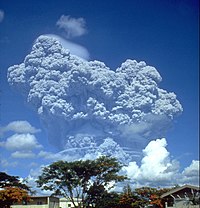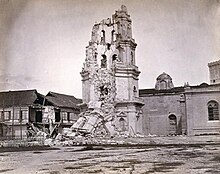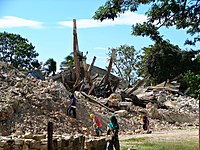| Event
|
Date
|
Notes
|
| Leonard Kniaseff |
c.120 AD.[1] |
There was a scare in 1995 but PHIVOLCS investigation at the time did not disclose any unusual activity, and no unusual activity has been reported since.
|
| San Pablo Volcanic Field |
1350 AD +/- 100 |
Last activity was the formation of Sampaloc Lake around 1350 AD +/- 100 years determined by anthropology[2]
|
| Taal eruption |
1572 to 2022 |
Currently on eruption since January 12, 2020. Eruptions have also destroyed numerous lakeside towns, burying them with volcanic ash or submerged them by rising lake waters displaced by the erupted material. The towns of Lipa, Taal, Sala, Bauan and Tanauan were formerly located along Taal Lake. Presently, only three towns are on the lake's shore. Remnants of the old lakeside towns are reported to be seen under the lake's waters.[3]
|
| Mayon eruption |
1616 to 2018 |
The most destructive eruption of Mayon occurred on February 1, 1814 (VEI=4). Lava flowed but not as much compared to the 1766 eruption; Instead, the volcano was belching dark ash and eventually bombarded the town of Cagsawa with tephra that buried it. Trees were burned; rivers were certainly damaged. Proximate areas were also devastated by the eruption, with ash accumulating to 9 m (30 ft) in depth. In Albay, a total of 2,200 locals perished in what is considered to be the most lethal eruption in Mayon's history; estimates by PHIVOLCS list the casualties at about 1,200, however. The eruption is believed to have contributed to the accumulation of atmospheric ash,[citation needed] capped by the catastrophic eruption of Mount Tambora in 1815, that led to the Year Without a Summer in 1816.
|
| Pinatubo eruption |
1500 to 2021 |
Reawakened in 1991 producing the 2nd largest eruption in the 20th century. Followed by milder eruptions in 1992 and 1993.[4]
|
| Mt. Kanlaon eruption |
1886 to 2024 |
The most active volcano in the Visayas, Kanlaon has erupted 26 times since 1919. Eruptions are typically phreatic explosions of small-to-moderate size that produce minor ash falls near the volcano. In 1902, the eruption was classified as strombolian, typified by the ejection of incandescent cinder, lapilli and lava bombs.
|
| Bulusan eruption |
1886 to 2022 |
Bulusan is generally known for its sudden steam-driven or phreatic explosions. It has erupted 16 times since 1885 and is considered as the 4th most active volcano in the Philippines after Mayon, Taal, and Kanlaon. There are evacuation procedures in place for parts of the peninsula, the farms nearest the volcano are evacuated, and many of the village schools are closed if it is considered possible that a more destructive eruption could occur.
|
| Mt. Hibok-Hibok eruption |
1827, 1862, 1871 and 1948–1952 |
On February 16, 1871, earthquakes and subterranean rumblings began to be felt in Camiguin, which increased in severity until April 30 when a volcanic fissure opened up 400 yards southwest of the village of Catarman, on the northwest flank of the Hibok-Hibok Volcano. From the opening, lava was continuously ejected and poured into the sea for four years destroying the town. At the same time, the vent started gaining in height and width thus forming Mt. Vulcan. In 1875, the Challenger expedition visited the area, and described the mountain as a dome, about 1,950 feet (590 m) in height, without any crater, but still smoking and incandescent at the top.[5]
|





